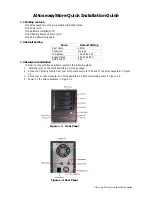
processor, memory and system level. OpenManage Power Center
delivers group power management at the rack, row, and data center
level for servers, power distribution units, and uninterruptible power
supplies.
Active power management
Intel Node Manager is an embedded technology that provides
individual system-level power reporting and power limiting
functionality. Dell EMC offers a complete power management
solution comprised of Intel Node Manager accessed through Dell
EMC iDRAC9 Enterprise and OpenManage Power Center that
allows policy-based management of power and thermals at the
individual system, rack, and data center level.
Hot spare reduces power consumption of redundant power
supplies.
Thermal control of fan speed optimizes the thermal settings for
your environment to reduce fan consumption and lower system
power consumption.
Idle power enables Dell EMC servers to run as efficiently when idle
as when at full workload.
Power supply units
Energy Smart power supplies have intelligent features, such as the ability to dynamically optimize efficiency while maintaining availability and
redundancy. Also featured are enhanced power-consumption reduction technologies, such as high-efficiency power conversion and
advanced thermal-management techniques, and embedded power-management features including high-accuracy power monitoring.
The system supports two hot-swappable AC power supplies with 1 + 1 redundancy, auto-sensing and auto-switching capability.
Thermal and Acoustics
The system's thermal management delivers high performance through optimized cooling of components at the lowest fan speeds across a
wide range of ambient temperatures from 10°C to 35°C (50°F to 95°F) and to extended ambient temperature ranges. These
optimizations result in lower fan power consumption for lower total system power and data center power consumption.
Thermal design
The thermal design of the system reflects the following:
•
Optimized thermal design:
The system layout is architected for optimum thermal design. System component placement and layout are
designed to provide maximum airflow coverage to critical components with minimal expense of fan power.
•
Comprehensive thermal management:
The thermal control system regulates the system fan speeds based on feedback from system
component temperature sensors, as well as for system inventory and subsystem power draw. Temperature monitoring includes
components such as processors, DIMMs, chipset, system inlet air temperature and hard disk drives.
•
Open and closed loop fan speed control:
Open loop fan control uses system configuration to determine fan speed based on system
inlet air temperature. Closed loop thermal control uses temperature feedback to dynamically adjust fan speeds based on system activity
and cooling requirements.
•
User-configurable settings:
With the understanding and realization that every customer has a unique set of circumstances or
expectations from the system, in this generation of servers, we have introduced limited user-configurable settings in the iDRAC9 BIOS
setup screen. For more information, see the Dell EMC PowerEdge system Installation and Service Manual on
Advanced Thermal Control: Optimizing across Environments and Power Goals
” on
•
Cooling redundancy:
The system allows N+1 fan redundancy, allowing continuous operation with one fan failure in the system.
48
Power, Thermal, and Acoustics
















































